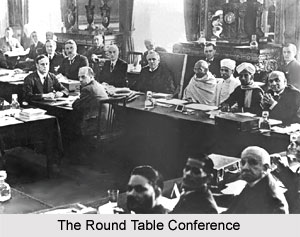 The Simon Commissions in India induced the dissatisfaction throughout India. It met a violent resistance in India and later the British Government organized for the Rounds Table conferences in order to take into consideration the demands and grievances of the Indians directly. Demands for Swaraj, or self-rule, in India had been growing increasingly strong. By the year 1930, many British politicians believed that India needed to move towards dominion status.
The Simon Commissions in India induced the dissatisfaction throughout India. It met a violent resistance in India and later the British Government organized for the Rounds Table conferences in order to take into consideration the demands and grievances of the Indians directly. Demands for Swaraj, or self-rule, in India had been growing increasingly strong. By the year 1930, many British politicians believed that India needed to move towards dominion status.
As announced by the viceroy on behalf of the Government of England on October 31, 1929, Round Table Conference was convened in London. After lengthy discussions, three basic principles were agreed in the Conference and the British Government was made to accept those principles.
Three basic principles were put forwards in the Round Table Conference. According to the agreement, it was demanded that form of the new government of India was to be an All India federation. The federal government, subject to some reservations would be responsible to the federal Legislature, according to the agreement. The provincial autonomy was also demanded by the Congress in the Round Table Conference. However, Ramsay MacDonald, the British Prime Minister, made a momentous declaration on behalf of His Majesty`s Government. According to the view of His Majesty`s government it was declared that the responsibility of the government should be placed upon legislatures, Central and Provincial with certain provisions as was considered necessary.
The absence of the Congress representations in Round Table conference led to a second session of the Round Table conference, where the Congress representatives would participate. Several efforts were made in that direction by Sir Tej Bahadur Sapru and Sir M.R. Jayakar, which led to the famous Gandhi-Irwin Pact, which was signed in March 1931. According to the Poona Pact, all political prisoners were released and the Civil Disobedience Movement was called off.
In the second Round Table Conference, Gandhiji was appointed as the representative of the Congress, which was convened from 1st September to 1st December in the year1931. But the significant issue of the Second Round Table conference was to solve the communal problem, which was not solved. This was because; Mr. Jinnah inflexibility was secretly supported by the British statesman like the Secretary of State for India. , Sir Samuel Hoare. Disappointed by the result of the session of the Second Round Table Conference, Gandhiji returned to India and subsequently arrested on his arrival in the country.
Ramsay Macdonald announced that in default of an agreed settlement as regards the respective quanta of representation of different communities, the British Government would have to arbitrate their claims. Subsequently, on August 4, 1932, Macdonald`s infamous "Communal Award" came into existence. The concept of Communal Award was related to the representation of different communities in the provincial legislatures. However the "Communal Award" declared by Ramsay Macdonald was partially modified by the Poona Pact. This was accepted by the Hindu rulers due to Gandhiji, who wanted to prevent a political breach between the so-called caste Hindus and the Scheduled Castes.
Consequently the third Round Table Conference was again convened in London on November 17th to December 24th in the years 1932. A White paper was issued in the year March 1933. The details of the working basis of the new constitution of India were enumerated in the White Paper. It was declared that according to the new constitution, there would be dyarchy at the Center and the responsible governments in the center . In February 1935, a bill was introduced in the House of Commons by the Secretary of State for India ,which subsequently passed and enacted as the government of India Act, 1935.
Thus the Government of India Act came into existence in the Third Round Table Conference. The Government of India Act drew its materials from the Simon Commission, the report of the All-Parties conference i.e. the Nehru Report, the discussions at the three successive Rounds Table Conference, the detail enumerated in the White Paper and the reports of the Joint Select Committees.






































